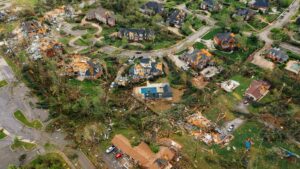Kamala Harris has made small business support a cornerstone of her presidential platform, presenting herself as a key advocate for entrepreneurs and innovators. From tripling lending to minority-owned businesses to driving venture capital to rural America, Harris has painted a picture of her leadership in this area as both Senator and Vice President. But how much of this is rooted in fact? A closer examination reveals that many of Harris’ claims are exaggerated or misleading, relying on broad economic trends rather than her direct influence. This post uncovers where Harris’ small business platform falls short, showing that her record is more fiction than fact.

Nathan Howard/AP Photo
Harris’ Leadership on Small Businesses: A Rhetorical Stretch
Kamala Harris claims to have led the Biden-Harris administration’s efforts to increase access to capital for small businesses. This gives the impression that she was at the forefront of economic initiatives designed to support entrepreneurs. However, her involvement seems to be more about promotion than policy-making.
The real driving forces behind small business relief during the pandemic were the Small Business Administration (SBA) and the Treasury Department, with significant input from Congress. The Paycheck Protection Program (PPP), for example, was established under the CARES Act and expanded by subsequent relief bills. Harris, while a vocal supporter, was not directly responsible for these initiatives. Her claims of leading the effort should be seen as overstated.
Even the American Rescue Plan Act (ARPA), which Harris supported, was a collective legislative achievement. The administration as a whole worked on these programs, and Harris’ specific contributions were largely in promoting them rather than designing or implementing them. If Harris is to be credited for supporting these efforts, it’s in the context of a team effort, not individual leadership.
A Senatorial Record Lacking in Substance for Small Businesses
Harris also claims to have been a champion for small businesses during her time as a U.S. Senator (2017-2021). But a review of her legislative record tells a different story. While Harris co-sponsored a number of bills supporting small business owners, particularly minority and women-owned businesses, she was far from a key player in crafting small business legislation.
Harris served on the Senate Judiciary Committee and focused more on issues like criminal justice reform, not economic policy. While she supported broader Democratic initiatives to assist small businesses, she wasn’t at the forefront of these efforts. Other lawmakers with long-standing roles on the Small Business Committee did more of the heavy lifting when it came to actual policy formation.
For example, Harris co-sponsored the Small Business Access to Capital Act, aimed at expanding lending opportunities for minority businesses, but this was part of a broader legislative package and not unique to her efforts. Simply supporting these initiatives is not the same as spearheading them, and there’s little evidence to suggest that Harris played a leading role in any landmark small business legislation.
The 19 Million Business Applications Claim: A Result of Circumstance, Not Policy
One of the cornerstones of Harris’ economic platform is the claim that the Biden-Harris administration drove 19 million new business applications during their time in office. While the number is accurate, the context behind this surge is less about innovative policy and more about pandemic-driven necessity.
According to the U.S. Census Bureau, business applications surged during the pandemic as individuals sought new ways to make a living after job losses or reduced work hours. This wave of entrepreneurship was driven more by economic desperation than by any specific policies Harris promoted. It’s misleading for Harris to take full credit for this surge, which was largely due to external forces rather than direct intervention from her office.
Additionally, the bulk of these applications came from solopreneurs and gig workers—businesses that may not contribute significantly to long-term economic growth. While these applications reflect the resilience of the American spirit, they cannot be fully attributed to Harris’ work in government.
Venture Capital for Middle America: Lofty Promises, Limited Results
Harris’ platform also highlights her efforts to direct venture capital investment to Middle America and rural areas—regions often overlooked by Silicon Valley investors. While this goal is admirable, there is little evidence that Harris has made meaningful progress in this area.
Venture capital typically flows to high-growth industries concentrated in urban innovation hubs like San Francisco, Austin, and New York City. While the Biden administration has promoted programs aimed at supporting rural entrepreneurs, there’s scant data to suggest that significant venture capital investment has been directed to these areas as a direct result of Harris’ involvement. Harris’ rhetoric on this issue outpaces the reality.
The Biden-Harris administration’s efforts to distribute more economic resources to underserved areas are commendable, but Harris has not been at the center of these initiatives. Much of the work in driving investment to rural America is part of broader infrastructure and economic programs that she has supported, but not led.
Federal Contracts for Minority-Owned Businesses: A Long-Standing Effort
Another area where Harris claims success is in expanding federal contracts for minority-owned small businesses. The administration has set a goal of increasing federal contracts to small, disadvantaged businesses to 15% by 2025. This goal, while important, is not unique to Harris or the current administration.
Previous administrations, particularly the Obama administration, laid the groundwork for expanding federal contracts to minority businesses. Harris’ support for this effort is part of a larger, ongoing trend that predates her tenure as Vice President. While she may have promoted the initiative, it’s not a new or groundbreaking effort under her leadership.
This claim, like many others, reflects Harris’ tendency to present long-standing government programs as personal achievements. The increase in contracts for minority-owned businesses is a positive step, but it’s part of a larger bipartisan effort that extends across multiple administrations.
Harris’ Distancing from Biden: An Inconsistent Strategy
As Harris gears up for a potential 2024 presidential run, she’s attempting to distance herself from Biden’s policies, yet her platform on small business development is heavily intertwined with the work done under the Biden-Harris administration. This contradiction undermines her attempt to carve out an independent identity.
If Harris is to take credit for the administration’s successes—whether in small business lending, increasing federal contracts, or driving business applications—she must also take responsibility for the policies and failures associated with Biden’s presidency. Trying to promote successes while distancing herself from the administration’s challenges creates an inconsistent narrative that weakens her credibility.
Conclusion: More Fiction Than Fact in Harris’ Small Business Record
Kamala Harris’ platform on small businesses paints her as a leader in driving economic opportunity, but the facts reveal a different story. Many of her claims—whether it’s leading small business efforts during the pandemic, supporting minority-owned businesses, or increasing venture capital in rural America—are exaggerated or lack substantive backing.
While Harris has certainly supported small business initiatives as part of the broader Democratic agenda, her actual leadership role is minimal. Much of the progress she touts can be attributed to larger economic forces or collective efforts by the Biden administration. Her attempts to distance herself from Biden while taking credit for shared accomplishments only further complicates her narrative.
In the end, Harris’ small business record is more fiction than fact. As voters consider her for the presidency, they should take a closer look at the reality behind her claims and ask whether her leadership truly delivered for small businesses—or whether it was just another political talking point.
References:
- “Paycheck Protection Program” — U.S. Small Business Administration: SBA.gov
- “American Rescue Plan Act” — U.S. Department of the Treasury: Home.Treasury.gov
- “Business Applications Surge Amid Pandemic” — U.S. Census Bureau: Census.gov






 The key elements of the Harris-Walz tax plan are designed around restoring and expanding two major tax credits: the Child Tax Credit (CTC) and the Earned Income Tax Credit (EITC). Additionally, they aim to raise taxes on high earners and corporations by rolling back Trump-era tax cuts and increasing capital gains taxes for wealthier Americans. Specifically, the Harris-Walz plan proposes to:
The key elements of the Harris-Walz tax plan are designed around restoring and expanding two major tax credits: the Child Tax Credit (CTC) and the Earned Income Tax Credit (EITC). Additionally, they aim to raise taxes on high earners and corporations by rolling back Trump-era tax cuts and increasing capital gains taxes for wealthier Americans. Specifically, the Harris-Walz plan proposes to:

 The immediate destruction caused by wildfires is devastating, but the long-term environmental effects, particularly those related to air pollution, are equally concerning. Wildfire smoke is a complex mixture of gases and fine particles released when organic materials like trees, shrubs, and grasses burn. The smoke contains several harmful pollutants that have significant impacts on both human health and the environment.
The immediate destruction caused by wildfires is devastating, but the long-term environmental effects, particularly those related to air pollution, are equally concerning. Wildfire smoke is a complex mixture of gases and fine particles released when organic materials like trees, shrubs, and grasses burn. The smoke contains several harmful pollutants that have significant impacts on both human health and the environment.





